There comes a point in my afternoons or evenings where I’ve just about sapped all the creativity and efficiency I’ve got. I need a break. My mind and my body—and oftentimes, my writing—make it quite clear.
Do we ever get the same clues when we need a break from social media?
Certainly, the subject seems a bit taboo to discuss. We’re social media marketers, after all! Taking a break from social media seems almost sacrilegious, yet I wonder how many of us have had those thoughts or feelings before. I know I have.
I thought I’d share a bit about what might go into the thought process behind pressing pause, taking a break, or outright quitting a social network. The circumstances are likely to be unique for each of us. Here’s hoping that this post might open the floor for some good discussion.
From my experience, a social media reset is helpful every now and then. Here’s how to do it.
A social media reset is helpful every now and then.
You’re not alone in wanting a break from social media
Maybe you’ve been posting consistently to social media for six months straight.
Maybe you’ve felt a little turned off by some of Facebook’s experiments or Twitter’s redesigns.
Maybe you’re just in the mood to reevaluate.
In any case, let’s say that you’ve chosen a social media vacation to take your mind off things.
You wouldn’t be alone.
The social media vacation—also popularly known as a social media cleanse—is simply time away from social sites. In most cases, it’s “taking a break” rather than “leaving forever.” Some folks have started a 99 Days Without Facebook challenge (think you could pull this one off?). Others choose to let a social media site fade into the background for a while and resume when things feel better.
It’s okay to take a vacation. We all need a break sometimes.
In fact, a surprising amount of us have pressed pause on our social sharing at one time or another. Here are a few numbers via eConsultancy.
- 32 percent of Facebook’s active monthly users choose not to log in every day
- 64 percent of Twitter users are inactive in a given month
- 65 percent of Google+ users are inactive in a give month
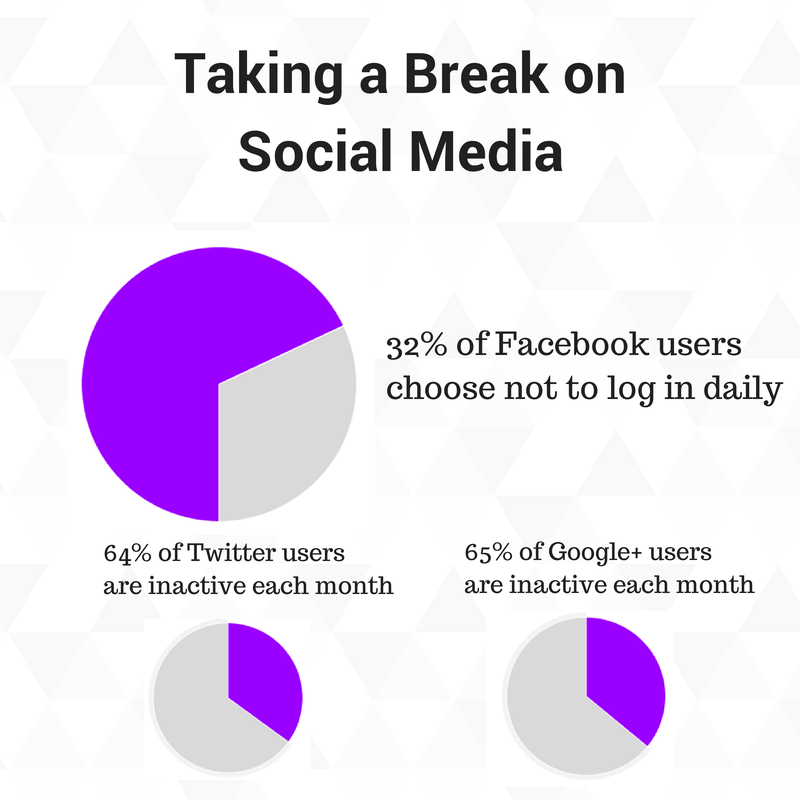
On Facebook, this means that 491 million active users take somewhat of a break each month. Twitter and Google+ combine for more than one billion unused accounts on a monthly basis.
Of course, what those numbers don’t indicate is the nature of the account in limbo. Some of the accounts are likely to be test accounts set up by well-meaning marketers or fake accounts set up by click-baiting spammers; some might be folks who reserved an account for a future, TBD use. Let’s ignore these groups for now and focus in on the two types of accounts that most likely affect you: personal accounts and company accounts.
How do people and brands decide to take a break from social media—or to leave it altogether?
People story: Press pause when it gets to be too much
If you search Google for the phrase “why I left Facebook,” you get 983 million results. Takeaway: A lot of people have left Facebook, and for many different reasons.
Elite Daily’s Rudolpho Sanchez left Facebook when he found himself spending more and more time and deriving less and less pleasure.
Jessica Ferris, writing on Medium, left Facebook over privacy and safety concerns.
These are a couple of extreme examples of people who have felt the need to leave a social network completely, instead of just taking a break. Still, their reasons for doing so might ring true whether you’re thinking about a social media vacation or a social media sayonara. These reasons could fit any network you’re on, too—not just Facebook.
- Lack of enjoyment
- Privacy and safety concerns
- Lack of time
- Lack of interest
- Too addictive
It’s this last point that I find quite interesting. In Jessica Ferris’s Medium article, she recounted a conversation she had with a Facebook user that might ring true for many of us.
I was talking with a woman in her 50s this weekend, who said to me, “I wish I could quit Facebook but it’s so addictive: ‘Oh, this person said this, that person said that, and oh, this person is taking boating lessons, let’s look at all the pictures of the boat,’ and then before I know it two hours have passed and I don’t even KNOW the person taking boating lessons!” This is what it feels like when your connections with a platform are being strengthened, as opposed to the connections with the people you love: you can spend two hours on Facebook looking at the boating lessons of people you don’t even know.
Kudos to those who recognize this behavior in themselves and who act on it with a change in the way they approach social media. I’ve yet to experience this phenomenon myself, but if I do, I’ve no doubt a vacation will be in order.
Brand story: Slow things down when your audience is elsewhere
Whereas many public stories of social media vacations for individuals end in the person leaving a social network altogether, brands are more likely to hold on to their accounts and simply update less frequently.
Business Insider highlighted the way that many brands have tried this tactic with Google+, choosing to ebb and flow in and out of social media pauses as they evaluate strategy and audience.
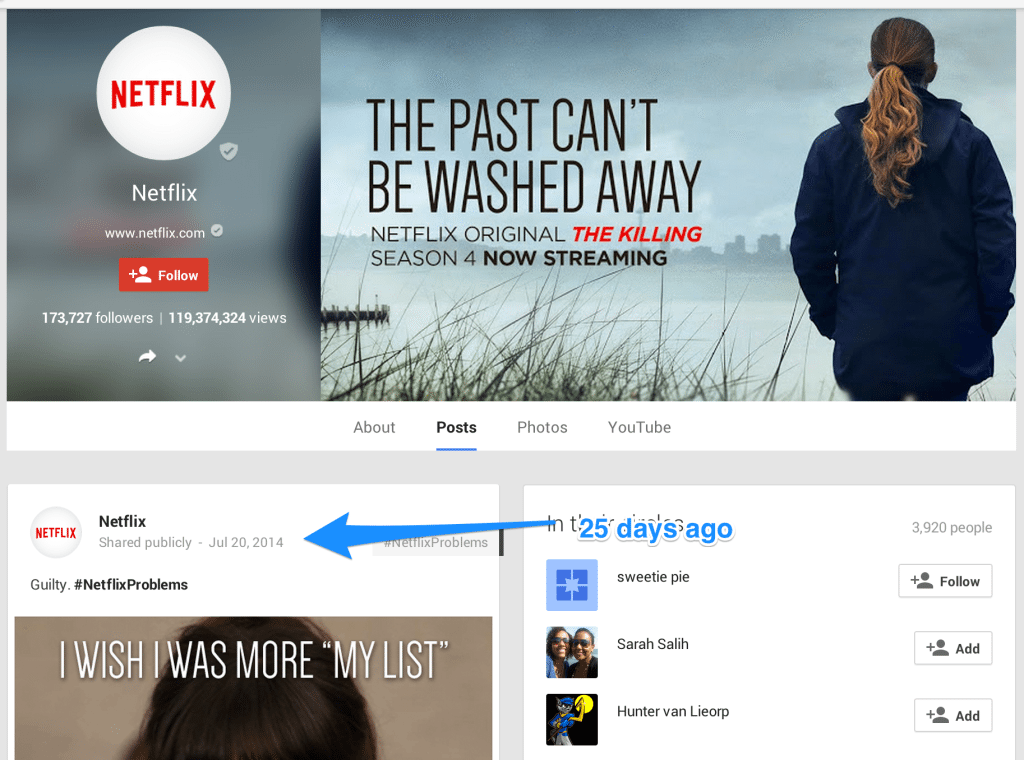
One of the most interesting quotes in the Business Insider story is from Dave Gilboa, co-founder of Warby Parker.
The main reason we are more active on Facebook than Google+ is because that is where our customers and our target demographic are spending their time.
In this sense, brands are choosing when to press pause, cool off, or leave social media based on the numbers. Here are a few areas that might be worth considering:
- Engagement rate
- Followers
- Conversions (either clicks on a status update or conversions through a marketing funnel)
- Referral traffic from an individual social network
- Time and resources on hand to maintain quality content
You may have noticed that four of the five elements listed above are statistics. The fifth is more of an intuition. You can check your analytics and your insights for the raw numbers, but how do you judge the more intangible aspects? Here are a few ideas and questions you can ask yourself.
What is the best way you can spend 30 minutes of your time?
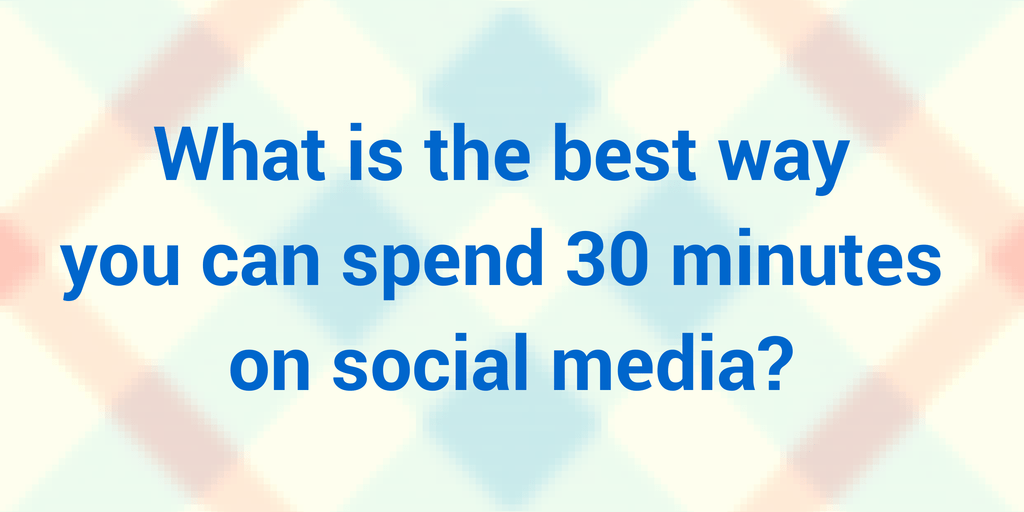
What if you have 30 minutes to spend with your social media marketing? Where would you spend it? What would you do?
If you’re struggling to know whether it’s time to press pause, slow down, or outright leave a social network, ask yourself this question. Your answer is likely to reveal your priorities.
What is the best way you can spend 30 minutes on social media? Your answer reveals your priority.
I’d imagine that you’d be unlikely to spend it on a network where you’re getting very little traction. Those 30 minutes would be better poured into your best-performing social media profile, creating something amazing, and investing in an audience that listens and engages.
And how often does it turn out that 30 minutes is all you’ve got? In my experience, this is the case quite often. A social media break might be just what we need to make sure our precious spare time is being spent in the best way possible.
The necessity of saying “no” on social media
I am a people pleaser, a “yes” person by default. One of my biggest challenges is saying no to others, regardless of the request. Saying yes is easiest at the moment when I’m giving the answer; saying no is easiest at virtually all other times.
Social media presents a litany of opportunities to practice saying no.
And it’s okay to say no as often as you want.
In the book Boundaries: When to Say YES, When to Say NO, To Take Control of Your Life, Dr. Henry Cloud and Dr. John Townsend talk about the feeling of guilt that often accompanies saying no and setting boundaries. Their conclusion: No one can make you feel guilty. Guilt is your choice. Be confident and self-assured, and you don’t have to worry about guilt.
Another key learning for me when it comes to guilt is the lessons shared by Michael Hyatt. He’s taken an opposite approach to the yes-man philosophy.
I have switched my default response from “yes” to “no.”
And his reasons for doing so are incredibly admirable. According to Hyatt, the risks of saying “yes” too many times are:
- Other peoples’ priorities will take precedence over ours.
- Mere acquaintances—people we barely know!—will crowd out time with family and close friends.
- We will not have the time we need for rest and recovery.
- We will end up frustrated and stressed.
- We won’t be able to say “yes” to the really important things.
If you feel that any of these might apply to you and your social media life right now, consider taking a pause or slowing down and finding a good balance that works best.
A lean approach to social: Build, Measure, Learn
One of the most popular ways of thinking at startups is to approach building a product with a lean mindset. Essentially, you start small (with a Minimum Viable Product), learn from it, and change and build based on the feedback. Here’s a helpful graphic that describes the lean approach.
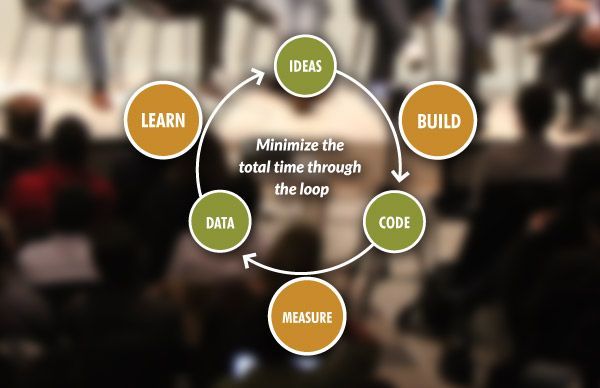
You could take the same approach with social. Build a presence on a social network, measure your results, and learn from your findings.
If it seems to be working, great! If it seems to be in need of changes, feel free to make the changes or pivot in a new direction. The benefit of starting lean is that you can move nimbly from one idea to the next.
Step-by-step actions for those who decide to pause or leave a social network
If you do decide that time away is in your best interests, there’re lots of options for you.
- Do nothing. Simply stop sharing, following, and favoriting, and step away from the computer.
- Deactivate your account. Reactive later.
- Delete your account. There’s no going back.
- Fill up the queue of your social media scheduling app, and let your scheduler post for you while you’re away. Consider it like a personalized auto-responder that just so happens to deliver great content as if you were still around.
1. Do nothing – step away from social media
This one’s definitely the easiest one to handle, and it’s the method that is likely to be most representative of the stats I mentioned at the top of this article. When social networks measure inactive users, they’re typically measuring this group.
There’s no timetable for these types of social media time outs either. Some people might break for a few days; others will leave altogether. And pausing in this way keeps your account visible and searchable even when you’re not posting, so people can still find, follow, and message you while you’re away.
2. Deactivate your account
Deactivation is a temporary solution for removing your account information from a social network. It’s a bit more extreme than simply stepping away for a time, and yet it’s still entirely reversible. You can reactivate at any time.
On Facebook – Go to https://www.facebook.com/settings. Click “Security” in the left-hand column. Click “Deactivate your account.”
Once you complete this process, your profile disappears from Facebook and people can no longer find you via search. Reactivation is super easy; just log back in when you’re ready to return. Facebook saves all your data and info for when you’re ready to come back.
On Twitter – Go to https://twitter.com/settings/account. Click the “Deactivate my account” link at the bottom of the page. Confirm your deactivation by typing your password.
Twitter will keep all your data and information on hand for 30 days, at which point it will be deleted if you haven’t reactivated your account. To reactivate, simply sign in.
3. Delete your account
This step is permanent. If you delete your account, you’ll likely have to start over from scratch if you decide to return. Here’s how to delete on Facebook, Twitter, and Google+.
On Facebook – The option to delete a Facebook account is rather hidden within Facebook’s help docs and menus. If you’re sure you’d like to delete your account, you can click this link. You’ll be prompted to fill in a CAPTCHA and asked to make extra sure this is what you want to do. If interested, you can download your Facebook history beforehand.
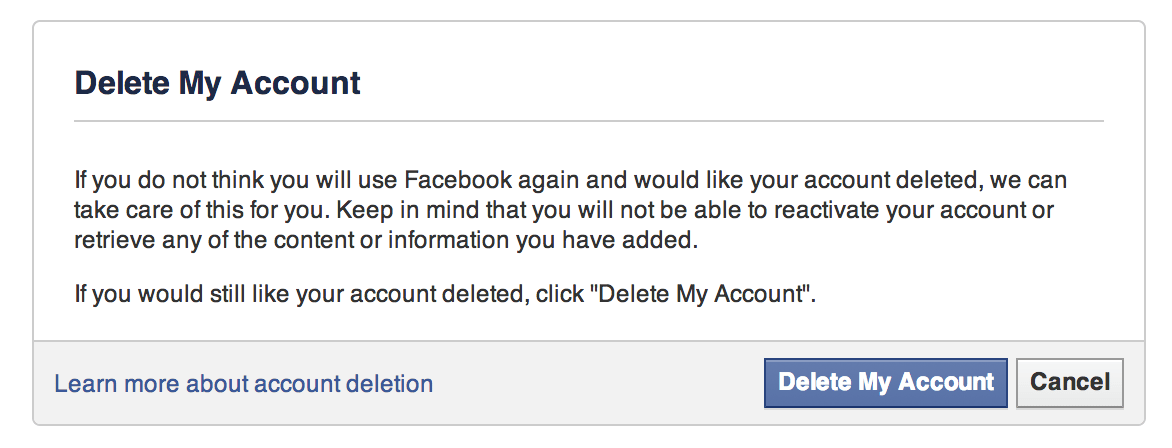
For Facebook pages, you can delete your page via settings. From your page, click on Settings and choose the bottom option to Remove/Delete Page.
On Twitter – There is no one-click button to delete right away. Follow the steps above for deactivation, then wait 30 days and Twitter will delete your account entirely.
On Google+ – From Google+, click the menu in the top left-hand corner and choose Settings. At the bottom of your settings page is the option to Disable/Delete your Google+ profile.
4. Fill up your queue
This fourth option fits well for those marketers who may need a break (or who may be taking an actual vacation) yet wish to keep their updates going. You can fill a scheduling queue that will post for you in your absence. We’ve collected a number of tips on social media automation that might be helpful as you plan your time away. Keep in mind as you’re scheduling: You might not be around to engage and reply. Post content accordingly.
Is a social media break right for you?
Hopefully you’ve now got a little more insight into why a social media break might be in order and how to go about it in the right way.
Is it a topic that you’ve thought about before? Have you followed through with a social media break in the past?
If it’s on your mind, consider some of the thoughts and ideas we discussed here—how to best spend your time, the benefits of saying no, taking a lean approach to social, and more. Social media has tons of advantages and uses when applied in the right way—and the right way so very often comes down to what feels right to you.
Image credits: The Lean Startup, Markus Spiske
Try Buffer for free
190,000+ creators, small businesses, and marketers use Buffer to grow their audiences every month.



